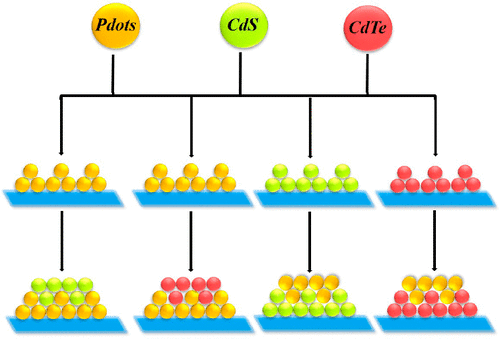当前位置:
X-MOL 学术
›
Anal. Chem.
›
论文详情
Our official English website, www.x-mol.net, welcomes your feedback! (Note: you will need to create a separate account there.)
Semiconducting Organic–Inorganic Nanodots Heterojunctions: Platforms for General Photoelectrochemical Bioanalysis Application
Analytical Chemistry ( IF 7.4 ) Pub Date : 2018-03-05 00:00:00 , DOI: 10.1021/acs.analchem.7b03852 Qian Wang 1 , Yi-Fan Ruan 1 , Wei-Wei Zhao 1, 2 , Peng Lin 3 , Jing-Juan Xu 1 , Hong-Yuan Chen 1
Analytical Chemistry ( IF 7.4 ) Pub Date : 2018-03-05 00:00:00 , DOI: 10.1021/acs.analchem.7b03852 Qian Wang 1 , Yi-Fan Ruan 1 , Wei-Wei Zhao 1, 2 , Peng Lin 3 , Jing-Juan Xu 1 , Hong-Yuan Chen 1
Affiliation

|
In this study, semiconducting organic polymer dots (Pdots) and inorganic quantum dots (Qdots) were first utilized to construct the organic–inorganic nanodots heterojunction for the photoelectrochemical (PEC) bioanalysis application. Specifically, n-type CdS Qdots, p-type CdTe Qdots, and tetraphenylporphyrin (TPP)-doped poly[(9,9-dioctylfluorenyl-2,7-diyl)-co-(1,4-benzo-{2,1′,3}-thiadazole)] (PFBT) Pdots were fabricated, and their energy levels, that is, their valence band (VB)/conduction band (CB) or lowest unoccupied molecular orbital (LUMO)/highest occupied molecular orbital (HOMO) values, were also determined. Then, these nanodots were integrated to construct four types of p-n and p-p organic–inorganic nanodots heterojunctions, that is, CdS Qdots/TPP-doped PFBT Pdots, TPP-doped PFBT Pdots/CdS Qdots, CdTe Qdots/TPP-doped PFBT Pdots, and TPP-doped PFBT Pdots/CdTe Qdots, on the transparent glass electrode. Upon light irradiation, four heterojunctions exhibited different PEC behaviors with some having prominent photocurrent enhancement. With the model molecule l-cysteine (l-cys) as target, the proposed PEC sensor exhibited good performances. In brief, this work presents the first semiconducting organic–inorganic nanodots heterojunction for PEC bioanalysis application, which could be easily used as a general platform for future PEC bioanalysis building. Besides, it is expected to inspire more interest in the design, development, and implementation of various organic–inorganic heterojunctions for advanced PEC bioanalysis in the future.
中文翻译:

半导体有机-无机纳米点异质结:通用光电化学生物分析应用的平台
在这项研究中,首先利用半导体有机聚合物点(Pdots)和无机量子点(Qdots)构建用于光电化学(PEC)生物分析应用的有机-无机纳米点异质结。具体而言,n型CdS Qdot,p型CdTe Qdot和四苯基卟啉(TPP)掺杂的聚[(9,9-二辛基芴基-2,7-二基)-co-((1,4-苯并-{2,1',3}-噻唑)](PFBT)制备了Pdot,并确定了它们的能级,即其价带(VB)/导带(CB)或最低未被占用还确定了分子轨道(LUMO)/最高分子轨道(HOMO)值。然后,这些纳米点被整合以构建四种类型的pn和pp有机-无机纳米点异质结,即CdS Qdots / TPP掺杂的PFBT Pdots,TPP掺杂的PFBT Pdots / CdS Qdots,CdTe Qdots / TPP掺杂的PFBT Pdots,和在透明玻璃电极上掺有TPP的PFBT Pdots / CdTe Qdots。在光照射下,四个异质结表现出不同的PEC行为,其中一些具有显着的光电流增强。与模型分子l-半胱氨酸(l-cys)作为目标,建议的PEC传感器表现出良好的性能。简而言之,这项工作展示了用于PEC生物分析应用的第一个半导体有机-无机纳米点异质结,可以很容易地用作将来PEC生物分析构建的通用平台。此外,有望在未来激发更多的兴趣,以设计,开发和实施用于高级PEC生物分析的各种有机-无机异质结。
更新日期:2018-03-05
中文翻译:

半导体有机-无机纳米点异质结:通用光电化学生物分析应用的平台
在这项研究中,首先利用半导体有机聚合物点(Pdots)和无机量子点(Qdots)构建用于光电化学(PEC)生物分析应用的有机-无机纳米点异质结。具体而言,n型CdS Qdot,p型CdTe Qdot和四苯基卟啉(TPP)掺杂的聚[(9,9-二辛基芴基-2,7-二基)-co-((1,4-苯并-{2,1',3}-噻唑)](PFBT)制备了Pdot,并确定了它们的能级,即其价带(VB)/导带(CB)或最低未被占用还确定了分子轨道(LUMO)/最高分子轨道(HOMO)值。然后,这些纳米点被整合以构建四种类型的pn和pp有机-无机纳米点异质结,即CdS Qdots / TPP掺杂的PFBT Pdots,TPP掺杂的PFBT Pdots / CdS Qdots,CdTe Qdots / TPP掺杂的PFBT Pdots,和在透明玻璃电极上掺有TPP的PFBT Pdots / CdTe Qdots。在光照射下,四个异质结表现出不同的PEC行为,其中一些具有显着的光电流增强。与模型分子l-半胱氨酸(l-cys)作为目标,建议的PEC传感器表现出良好的性能。简而言之,这项工作展示了用于PEC生物分析应用的第一个半导体有机-无机纳米点异质结,可以很容易地用作将来PEC生物分析构建的通用平台。此外,有望在未来激发更多的兴趣,以设计,开发和实施用于高级PEC生物分析的各种有机-无机异质结。



























 京公网安备 11010802027423号
京公网安备 11010802027423号